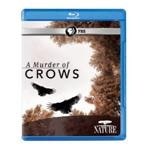American Crow: Where they Nest, Egg Laying, and Everyday Habits
Last updated: August 30, 2025
You'll also discover their courtship displays, feeding habits, and roosting routines.
All the behaviors that make crows one of the most intelligent and social birds you'll encounter.
Every bird-watching guide describes the American Crow as one of the most intelligent birds. Other adjectives include resourceful and mischievous.
Any way you describe them, these birds are worth watching as they go about their nesting and feeding habits.
Identifying: Size - Field Marks
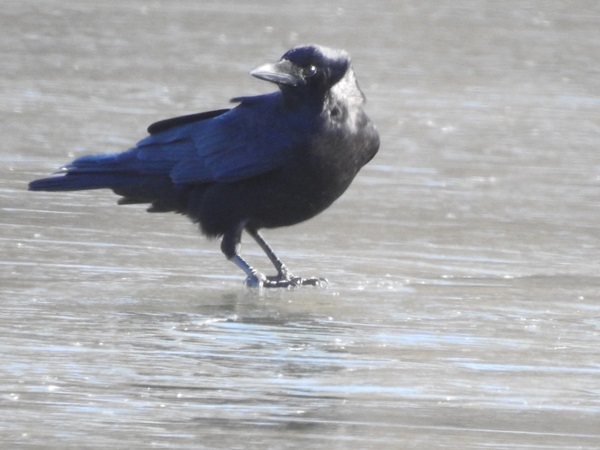
The American Crow is 17 to 21 inches in length. All black with a fan-shaped tail.
Both males and females are similar in appearance. The Crow's voice is the best way to distinguish it from other all-black birds.
American Crow Call, Sound
The voice is a long, descending "caaaw". Although it has a variety of other calls which are important to its system of communication.
Breeding Season, Mating, and Courtship Behavior
The breeding season of the American crow may begin as early as late February through March. However, egg laying begins in April and can go through May.
If first attempts fail, a pair may try during June.
The courtship behavior of American Crows is as fascinating as it is complex.
During the breeding season, males will face the female, fluff their body feathers, spread their wings and tail slightly, and bow repeatedly.
These movements are often accompanied by a short, rattling song that is very different from their usual "caw."
In addition to these displays, males sometimes present food items to females. This courtship feeding helps strengthen the pair bond and shows that the male is capable of providing for the family.
Once a pair bond is established, the birds may perch together, gently touch bills, and preen each other's feathers. These quiet acts of bill touching and allopreening reinforce the long-term partnership between the two birds.
Although crows often choose one mate for life, courtship displays are still important for forming and maintaining the bond.
These behaviors continue throughout the year between mated pairs.
In some cases, small groups of males may perform their displays in front of a female before she selects her mate.
Once a pair has formed, they work together closely during nesting and raising their young, often with help from offspring of previous years.
How Do Crows Mate?
Crows, like most birds, reproduce through sexual reproduction. The male crow mounts the female to transfer sperm, which fertilizes the eggs inside the female.
The female then lays the fertilized eggs, which develop and hatch into chicks.
This is the physical process of breeding for crows.
Once a male and female have mated, they perch together and may touch bills and preen their mate's feathers.
This particular mating behavior may not be seen very often because American crows mate for life.
Pairs already mated rarely have courtship displays. They breed or mate in the same way as other birds and mammals.
Pairs that are unsuccessful at breeding will part ways and return to their families.
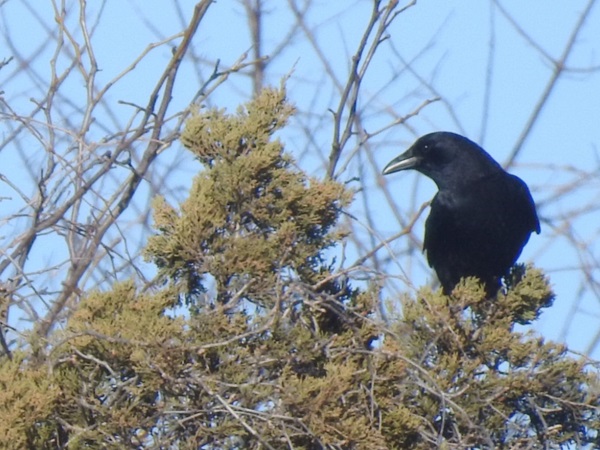
Should a mate die, the surviving mate will eventually find a new mate.
Crows also demonstrate cooperative breeding. This is when the previous year's young help raise the newest brood.
You can read more about cooperative breeding in our article here - Helper Birds
It's not unusual for males to wait a few years before mating.
Nesting Habits and Identifying Their Nest
They are very secretive around their nest. While noise is a mainstay of its behavior in other areas, the nesting site is quiet.
Crows nesting habits begin as early as March; construction of the nest takes about 2 weeks to complete.
Spring storms can destroy nests. This may cause nest construction to last through June. During poor weather no nest building takes place.
Where Do Crows Nest?
It can be difficult to find where crow's nest, but here are some clues. Crows place their nest in the top 1/3 of the chosen tree 18 to 60 feet above the ground.
They make sure the nest has a canopy of leaves above that hides it from predator hawks.
They build the nest near the trunk on a horizontal limb.
Nest Construction and Use
The female is the primary arranger of the nest. Both adults bring twigs and sticks for the outside and bottom of the nest.
The inside will be lined with bark, grass, and moss horsehair, or fur. The nest is about 15 to 16 inches in diameter.
Last years young may bring nest material to the female and she will use it in the nest building. The sides of the nest can be 9 to 10 inches high.
Crows do not use the nest in winter. They will roost or sleep in large numbers in a group of trees.
Most nests are abandoned after a single use, although a new nest may be built in the same tree the following season.
You can see what a typical American crow's nest looks like in the picture below.
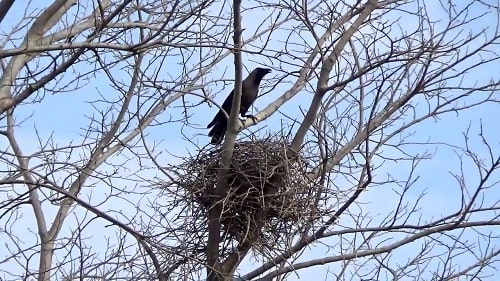
Eggs, Incubation, and Young
The female begins laying eggs once the nest is complete. She usually lays 1 egg each day for a clutch size of 3 to 6 eggs. Some females may skip a day or two between laying.
The average nest contains 4 eggs which are bluish-green with brown marks or blotches of darker colors.
Incubation (gestation period isn't used for birds)is done by the female with the male close by.
The male feeds her either on the nest itself or at a short distance away, calling to her first to draw her to the feeding location.
The eggs will hatch after 17 - 20 days of incubation.
The young are born blind and flesh-colored. After about five days, their eyes will open for the first time.
| Quick Nesting Facts | |
|---|---|
| Eggs | 3 - 6 (average 4) |
| Incubation | 17 - 20 days |
| Nestling Phase | 33 - 43 days |
| Broods | 1 |
Both parents feed the young, receiving help from previous years young.
At 4 - 5 weeks of age, the fledglings will leave the nest. Mostly they stay in the nest tree for several days while adults continue feeding them.
Crows only lay eggs once a season unless a storm or predator attack interrupts the first attempt. They may decide to re-nest in those cases.
Young males will return to their parents if their first attempt at mating and nesting is unsuccessful.
Habits of the American Crow
American Crows have a wide range of habits that make them one of the most recognizable birds in North America. These habits include their daily routines, feeding strategies, social behavior, and communication skills.
Daily routine: Crows are active throughout the day, feeding mostly in the early morning and late afternoon.
In fall and winter they gather by the thousands in communal roosts, traveling many miles from their feeding grounds to spend the night together.
Social behavior: They are family-oriented birds that often stay with their parents for more than a year.
Older young may help feed and protect new nestlings in a behavior known as cooperative breeding.
Outside the nesting season, crows often forage and travel in small flocks, keeping watch for predators while others feed.
Vocal and feeding habits: Crows are highly vocal, using a wide range of calls to alert each other to food, danger, or intruders.
Their diet is varied and opportunistic, from insects and small animals to fruits, seeds, carrion, and even the eggs of other birds.
They have also been observed dipping food in water, a habit that may soften tough items or clean them before eating.
Together, these habits show why crows are considered among the most intelligent and adaptable birds.
For more details, see the sections below on Feeding Habits, Mobbing Behavior, and Where They Roost.
Feeding Habits - What Do Crows Eat?
The diet of Crows consists of insects and small reptiles, carrion, fruit, and crops such as corn. They will also eat eggs and nestlings of other birds.
Crows tend to be opportunistic feeders, eating whatever is available.
During the nesting season of other songbirds, you may not want to use bird feeders if you have Crows around.
They will find a songbird nest and feed from those nests.
Crows are the wariest while feeding. Feeding in flocks of 5 to 7 birds, they will arrive on their feeding territory, landing in the trees.
While most will begin feeding on the ground, one or more will remain in the trees watching for predators.
Cracked corn and sunflower seeds will attract these birds, although they will eat about any kind of seed.
Crow Mobbing
One commonly seen behavior of crows is the habit of "mobbing" perceived threats.
When you hear them giving harsh, drawn-out caws and see them diving into treetops, chances are there is a hawk or owl in the tree.
The purpose is to drive off what they know is a predator of their young.
Even if the intruder leaves the area, the crows will continue to chase after it for a while longer, making sure it's gone from their territory.
One reason for this behavior, other than just chasing predator birds away, is to teach their young who their predators are.
According to the PBS Nature Program "A Murder of Crows", these birds may even be able to distinguish between one human and another.
Crows may be able to communicate to others whether a certain human is to be feared by recognizing features and remembering past actions.
Where Do They Roost and Sleep?
In fall and winter, the American Crow roost in large flocks, numbering sometimes in the thousands.
Each day in the late afternoon, the birds begin flying along fixed routes to pre-roost sites, gathering with other flocks and moving to the final roost.
They may fly as far as 50 miles every day to join the roost.
Once there, they quiet down for the night, waiting for dawn to fly back to their feeding territories.
Why Do They Fight With Each Other
I'm asked from time to time why crows fight with each other, even to the death.
Sometimes it's as simple as not being a family member.
While they are social birds, they may chase away those not of the family to protect territory or mates.
It may seem cruel, but sometimes a sick, injured or otherwise physically compromised bird may be attacked by others.
Weak animals are always at risk from predators. These birds may have some sense of that vulnerability.
Dipping Their Food In Water?
Another question that comes up is, why do they moisten their food in bird baths and other water sources?
No one knows for sure. Theories exist. Some believe they are cleaning their food.
Since crows are intelligent opportunistic feeders, eating food from human trash and landfills, it's believed by some that they've evolved to clean their food before eating.
Another thought is that they use water to moisten dry food and soften hard food types such as peanuts.
Still, others believe crows dip their food to provide moisture for the nestlings during the nesting season.
This would provide water to the young while still in the nest. See, How Baby Birds Get Water in Nest.
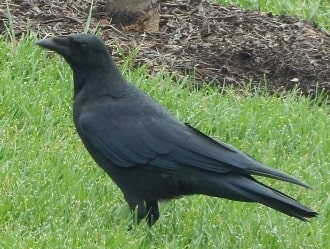
Winter Behaviors and Family Bonds of the American Crow
As nesting duties end in late summer, American Crows shift into a very different pattern of behavior for fall and winter. During these months, the focus turns from raising young to survival in larger social groups.
Food sources change as insects and crops disappear, and crows expand their range to search fields, woodlots, and even urban areas for grains, nuts, and carrion.
Winter also brings the formation of massive roosts, sometimes numbering in the thousands.
Each afternoon, family groups and neighboring flocks travel along fixed routes to gather at pre-roost sites before settling in for the night.
These large communal roosts provide warmth, protection from predators, and valuable opportunities for younger crows to learn from older birds.
At dawn, the flocks break apart, with family groups returning to their smaller feeding territories.
Although the extended family bonds remain strong, winter flocks are more fluid, mixing unrelated groups together.
Within these gatherings, young crows continue to interact with their parents and siblings, reinforcing bonds through calls and preening, while also learning to navigate the larger social world.
This balance between loyalty to the family unit and cooperation within the larger winter flock is part of what makes the American Crow one of the most social and adaptable birds in North America.
Pros and Cons of Feeding Crows
Feeding crows can be rewarding, but it comes with both benefits and drawbacks. Understanding these helps you decide whether attracting crows to your yard is the right choice.
Pros: Crows are highly intelligent birds that recognize food providers, and some will even form long-term associations with people.
By offering food, you may enjoy close-up views of their behaviors, including tool use, food caching, and family interactions.
Crows also help control insect and rodent populations, making them valuable neighbors in many habitats.
Cons: Crows are opportunistic and may raid the nests of smaller songbirds during the breeding season.
They can also become bold around human food sources, sometimes scattering trash or harassing pets.
Feeding them regularly may attract larger flocks than you intended, which can be noisy and may not be welcomed by neighbors.
In some areas, large crow gatherings have led to complaints or conflicts with local communities.
For those who choose to feed crows, it is best to do so in moderation. Offer foods like unsalted peanuts in the shell or cracked corn, and avoid processed human foods.
Providing small amounts at consistent times helps maintain a healthy relationship without encouraging dependency or overly large flocks.
